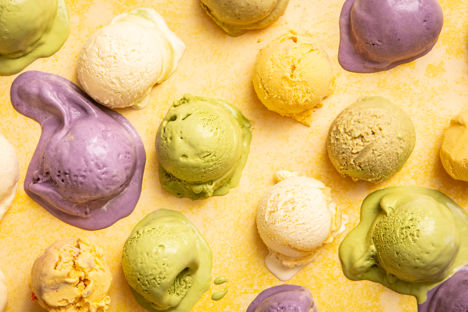Gelato and ice cream may appear similar at first, but gelato actually contains much less fat as it’s made with more milk than cream, and is churned at a much slower speed than ice cream. This low fat and low speed churning creates a much denser, silkier texture which lends itself to more intense flavours. As ice cream is churned faster, much more air is incorporated creating a lighter, fluffier consistency.
Most ice cream machines come with gelato settings, meaning that it is easy to make gelato at home as long as you have the right ingredients. Whole milk, a few eggs, cream and sugar is typically all you need, along with any flavourings such as fruit purees or nut pastes. If you don’t have an ice cream machine, you can still make gelato at home but it may take a little more effort. First prepare your base by heating the milk, cream and sugar, then tempering it to the eggs. Heat this mix until it thickens slightly then mix in your desired flavourings. Chill the mix then place into a container in the freezer and whisk vigorously every 30 minutes to incorporate air. Repeat this process for around 5 hours, or until the gelato has reached a smooth, creamy consistency.
Metric
Imperial
- 1 vanilla pod, sliced in half lengthways
- 500ml of whole milk
- 200ml of heavy cream
- 150g of caster sugar
- 2 Freshlay Farms Golden Yolker® egg yolks
Begin by preparing the vanilla bean. Slice it lengthwise and scrape out the seeds using the back of a knife
Add the seeds and vanilla bean pod to a saucepan
Next, add the milk and cream to the same saucepan along with half of the sugar
Heat gently until it reaches steaming point, but avoid simmering or boiling the mix
In a separate bowl, whisk together the egg yolks and the remaining sugar until the mix is pale and begins to thicken
Temper the warm milks mix to the egg yolks, by slowly pouring a small amount of the milk to the eggs while whisking constantly to prevent the eggs from cooking
Gradually add more of the hot milk to the eggs as you continue to whisk
Pour the tempered egg mix back into the pan, then cook over a low heat, stirring constantly until the mix thickens slightly and can coat the back of a spoon
The mix should reach around 80°C, but do not let it boil
Remove the saucepan from the heat along with the vanilla bean pod
Strain through a fine mesh sieve into a clean bowl, then leave to cool at room temperature before transferring into the fridge and chilling for 4 hours
Once the mix is thoroughly chilled, pour it into the ice cream machine and churn on the gelato setting according to manufacturer instructions
After churning, transfer the gelato base into a freezer safe container, and freeze for at least 2 hours to firm up before serving
Gelato does not have to include eggs, but a lot of recipes do use them, especially the traditional Italian recipes which use a custard base. Eggs, specifically egg yolks, create a richer texture and enhance the creaminess of the gelato. On the other hand, lots of modern gelato recipes omit eggs, relying instead on a balance of milk, cream and stabilisers to achieve a similar consistency. Some say that egg-based gelato creates a more luxurious mouthfeel and depth of flavour, while others prefer the lighter texture that comes with the egg-free versions.
To store homemade gelato, make sure to transfer it into a freezer safe container right after churning. Press a piece of plastic wrap or parchment paper directly onto the surface of the gelato before sealing the container to prevent ice crystals from forming. Store the gelato in the coldest part of your freezer, usually in the back, to help maintain a consistent temperature. Homemade gelato is best eaten within two weeks, as it doesn’t contain the same preservatives found in commercial products and can begin to deteriorate in texture over time. When ready to serve, make sure to let the gelato sit at room temperature for a couple of minutes to let it soften slightly before enjoying.
For pastry chefs, using ice cream and gelato bases to try out bold flavours and unique variations is a great way to experiment with desserts. At GBC, we have a huge selection of tried and tested ice cream and gelato recipes perfect for giving a go at home, whether you are looking for something unique and eye-catching like Heinrich Schneider’s birch ice cream with black bean pesto, spiced cream and milk skin, or maybe something more classic like Antonia Klugmann’s chamomile ice cream with lemon meringue and almond crumble.
Get in touch
Please sign in or register to send a comment to Great British Chefs.



